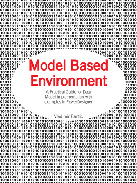"The physical data modeler and the DBA have to be able to understand each other when working together. Believe it or not, this is not always the case."

 |
Model Based Environment by Vladimir Pantic Trafford Publishing
book review by John E. Roper
The dawn of the Information Age brought with it an increased familiarity on the part of the average computer user with the basic database. But while this common software tool may have been fine in a simplified form for the masses, businesses have often been forced to seek out or even develop for themselves software that is more robust and complex to meet their individualized needs. Unfortunately for software developers, the System Development Life Cycle (SDLC) is sometimes rushed through its various phases due to time constraints placed on the completion of the project. When this occurs the result is a product that is less than ideal. The author, with over twenty five years of experience in the fields of Data Modeling and Physical Database Design, brings his expertise to bear on the problem with his detailed guide to working within a Model Based Environment (MBE) in order to effectively "analyze, design, implement and maintain the database throughout its life-cycle."
Although written for experienced modelers who may be seeking techniques to improve and streamline their work, Pantic does an excellent job of defining terminology and exploring his topic in a step-by-step manner for those needing a more simplified approach to the subject. For example, while heading toward the ultimate goal of using the physical data model in development he takes the time to adequately explore the conceptual and logical data models and show how developers in each of these areas can make transitions between the models smoother. In addition, he includes helpful screenshots from PowerDesigner to illustrate his points while frequently referencing Oracle and DB2, two popular database management systems undoubtedly familiar to his audience. While probably too technical for the typical layman to absorb, Pantic's book should prove to be a valuable resource for IT professionals.
RECOMMENDED by the US Review